Nokia Lumia 900 Review - Windows Phone with LTE
by Brian Klug on April 3, 2012 9:00 PM ESTCellular, WiFi, GPS, Speakerphone
The Lumia 900 uses Qualcomm’s MDM9200 baseband for cellular connectivity. It’s a 45nm LTE UE category 3 part we’ve seen numerous times before (the MDM9600 is functionally the same but includes CDMA2000 1x and EVDO 3GPP2 suite air interface support) but this is the first time we’ve seen it (and LTE) on a Windows Phone. I have to admit that at first I wondered what use cases on Windows Phone could really benefit from the inclusion of LTE, but having faster cellular connectivity does indeed make a perceptible difference. Interestingly enough Nokia does note the presence of Rx diversity for WCDMA on the Lumia 900 front and center, both under their “design” tab and under Data Network on the specifications page. It’s awesome to see another handset vendor realize that great cellular performance is noteworthy, even if Nokia has always been shipping handsets with either pentaband or great performance.
| Nokia Lumia 900 AT&T- Network Support | |||||
| GSM/EDGE Support | 850 / 900 / 1800 / 1900 MHz | ||||
| WCDMA Support | 850 / 900 / 1900 MHz (official, 2100 / AWS in FCC) | ||||
| LTE support | 700 MHz (Band 17), AWS (Band 4) - UE Category 3 | ||||
| Baseband Hardware | QCT MDM9200 | ||||
| HSPA Speeds | HSDPA 21.1 (Cat 14) / HSUPA 5.76 (Cat.6) | ||||
Since the Lumia 900 is headed to AT&T LTE, it includes LTE band 17 (700 MHz) and band 4 (AWS) support. For 3G WCDMA the Lumia 900 supports the usual suspects outlined in the table below, but also includes AWS approval in the FCC database. Were you to score an unlocked Lumia 900 there’s a chance it might just work on T-Mobile. Just like the Lumia 800 I suspect there are a few variants of the Lumia 900 with different WCDMA bands supported.
To test cellular performance I used BandWidth from the Marketplace which appears to use the speedtest.net servers. I tested AT&T LTE up in the Phoenix, AZ market which is currently 10 MHz FDD-LTE on band 17 for AT&T which corresponds to a maximum of 73 Mbps of downstream for a UE Category 3 device. BandWidth only offers a limited history buffer and no export functionality, but I saw speeds of up to 35 Mbps on the Lumia 900 and average speeds around 15–20 Mbps. Subjectively what I’ve seen on the Lumia 900 is very similar to the performance I’ve seen testing an AT&T Galaxy Note in the same market whose data I’ll share soon.
On 3G WCDMA, performance is definitely helped out by the presence of Rx diversity. I have seen 10–11 Mbps at my house with excellent proximity to an AT&T cell site. In other traditionally challenging places the Lumia 900 does a great job staying connected in my home market which lacks AT&T LTE.
The Lumia 900’s cellular settings page includes the ability to switch the device’s preferred air interface between EDGE/GPRS (E), 3G WCDMA (3G), and 4G LTE (4G). However the labeling here is actually hilarious - AT&T’s WCDMA “4G” marketing carries over to the Lumia 900, so selecting “3G” from the drop down will score you a “4G” indicator in the status bar. Likewise selecting “4G” from the drop down gets you “LTE” in the status bar. Finally, a concrete example of where AT&T’s re-branding marketing has resulted in an actual namespace collision!
I think it’s also worth noting that the Lumia 900 includes an excellent field test app with fields for every air interface which you can launch by dialing ##3282# just like on many other WP7 devices.

Antenna positions (from FCC Test Report)
Like many other phones, the transmit antenna is at the bottom of the device for GSM, WCDMA, and LTE. The WCDMA Rx diversity antenna and LTE MIMO antenna is located on the side with the volume and power/standby buttons. Remember that every LTE category 2 and above device needs two receive antennas for MIMO.
A number of users have asked me whether or not the Lumia 900 works with any old AT&T SIM, or if you absolutely need the SIM that comes with the device and LTE provisioning. I swapped my normal iPhone data plan provisioned SIM into the Lumia 900 and was able to get 3G WCDMA working fine. I didn't get a chance to test whether AT&T LTE works with that SIM, but I strongly suspect it doesn't. One small extra step is that you will need to use Nokia’s Network Setup application (available on the Marketplace) to change your settings from AT&T LTE to AT&T 3G APNs as shown above (ostensibly from pta to phone) so you can get data working, otherwise it won’t work.
WiFi
The Lumia 900 includes 802.11b/g/n WiFi - there’s only 2.4 GHz support just like every other WP7 phone, no 5 GHz yet to speak of. The device also connects at a single spatial stream 802.11n 72 Mbps short guard interval, 20 MHz channel rate. I’m fairly confident that the Lumia 900 is using Broadcom’s BCM4329 just like the Lumia 800, but I’m unable to verify to be completely sure. Either way I haven’t seen anything errant with WiFi on the Lumia 900 at all, range and performance is totally acceptable.
The Lumia 900 locates the WiFi, Bluetooth and GPS antenna in the same place, part of a module which appears to be part of the headset jack based on the FCC description.
GPS
Speaking of GPS, I had no issues at all with getting a good GPS fix on the Lumia 900 either while just playing with Bing maps, Nokia Maps, or while getting turn by turn directions from Nokia Drive. I strongly suspect that the Lumia 900 is using the GNSS functionality off of MDM9200, but it’s not clear whether GLONASS is supported or this is just GPS.
Speakerphone
The Lumia 900 speaker is at the very bottom of the device, just like the 800. Subjectively I have no issues with the 900's volume at all, either while on a speakerphone call or using it for navigation using Nokia Drive. In our controlled test with a sound data logger placed 3 inches away from the phone, the result the Lumia 900 is above average and definitely louder than the Lumia 800.
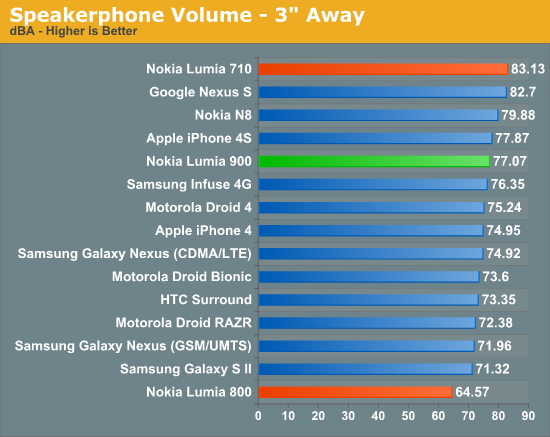
The next test is how well the Lumia 900's noise rejection works, which uses the second microphone at the very top in conjunction with the primary microphone in the speakerphone grille at bottom to do some common mode noise rejection. To test this I did what I always do and placed a call between the Lumia 900 and another AT&T phone (AMR-NB) and recorded the output of that call while increasing the volume of some music and decreasing it.
The results are excellent, as even at maximum volume I have a hard time discerning the background sound at all. I suspect that Nokia is using the Fluence noise rejection provided onboard the Qualcomm SoC, but I'm still not completely certain.


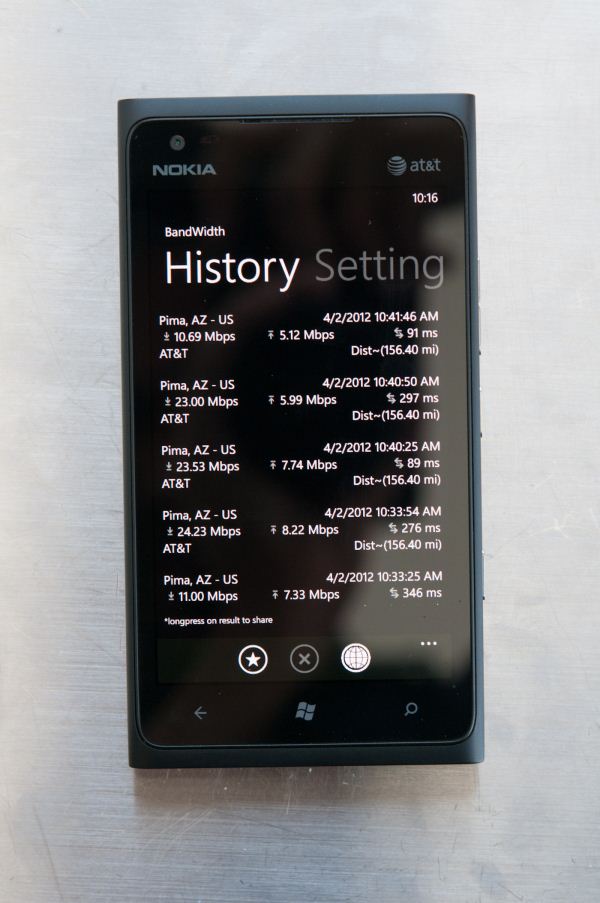
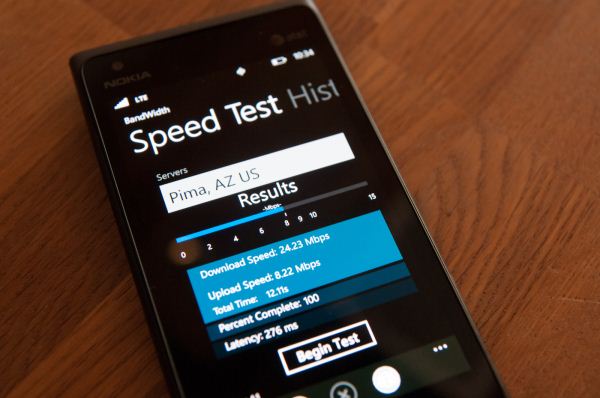
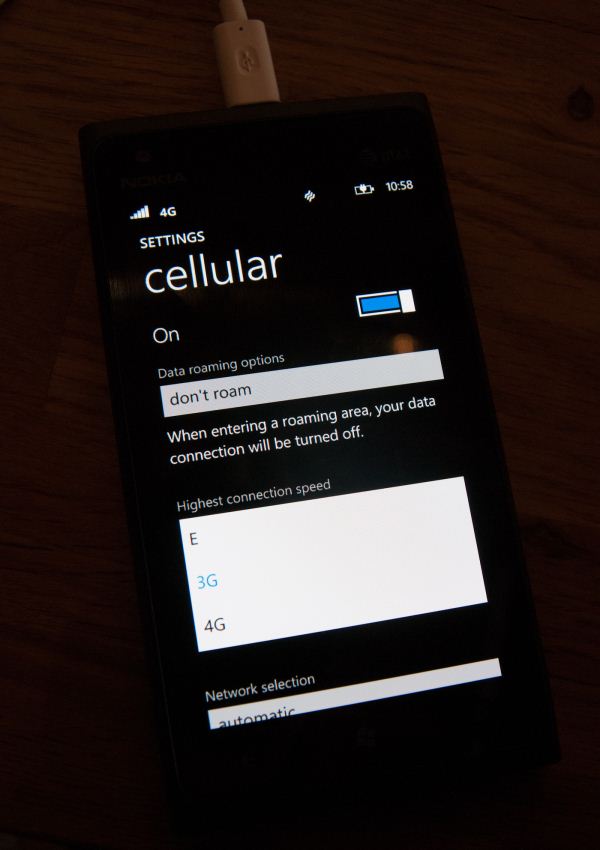
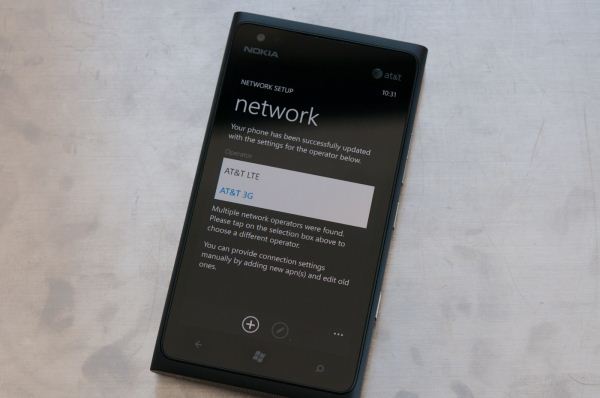








128 Comments
View All Comments
UltraTech79 - Saturday, April 7, 2012 - link
Also, no most people do NOT like the design, else they would be buying these and not Droids/iPhones by the truckload.jmcb - Tuesday, April 10, 2012 - link
To me battery life on WP7 has never been as great as many claim since WP7 launched. I usually reference this site for results, debates.Battery life is part of my deal breakers for any phone.
gamoniac - Tuesday, April 3, 2012 - link
[quoteThe article: ]...the only major gripes I have with Nokia Drive are that the application arguably should change between night and daytime map colors automatically...[/quote]I checked out this feature at the store, I think WP7 should let you decide whether to let the map color or to set it to manual mode. Some people might find the daylight map easier to read during the night.
vision33r - Tuesday, April 3, 2012 - link
Well, in general if Android doesn't suck so much none of us really need a quad-core phone. Clearly WP is much more efficient platform than Android today so a single-core phone can be this solid and for most people this translates to feeling faster than most Android phones that lags when apps are running and sans performance.Nearly every Android device I've used today needs manual management in order to run smoothly. Letting a single widget or app sitting background too long, battery life and performance suffers. Android's entire ecosystem is to blame for faulty app coding to OS builds rigged with bloatware.
This is a refreshing device, hopefully people will not care about the specs and embrace efficiency and good hardware and software designs.
gamoniac - Tuesday, April 3, 2012 - link
I totally agree. I am held back from jumping on a WP7 for two reasons: WP8 is coming and a dual-core WP would be great.I respect AnandTech's spirit of journalism that makes it stand out among review sites. At the same time, I wonder if there is a fair way to rate the phone based on total user experience, in a somewhat quantifiable way, as opposed to core count or a simple opinion. Perhaps a weighted score of each of the categories, although that could still be subjective. Perhaps a short video review? Maybe some AT readers have some brilliant ideas to share.
davepermen - Wednesday, April 4, 2012 - link
a total user experience rating?here it is:
always smooth, always instant, never stuttering.
why should I care about "faster hardware" if the phone is already perfoming at it's best possible speed?
this rating is based on the lumia 800 i own.
i've yet to find an android phone as smooth and fast as the lumia 800.
i can't wait for apollo, out of the curiosity of what's all in there, and all those tiny features that a win8 kernel brings (WPS for Wifi connection, for example, proper windows updates, etc).
but at no point i wait for apollo to "get a fast phone". because i already have that.
french toast - Wednesday, April 4, 2012 - link
Yes good point..its efficient and fast..but too be honst Meego and even Symbian is even faster still..running on even worse hardware than this....The point is smoothness and efficiency is great...brilliant, but what about things like batterylife? HD displays? powerfull apps and GAMES?? 1080p video recording and editing?? True multitasking?? its not all just about sending a few emails, checking facebook, and floating around in the opererating system...on android and ios you can do soo much more than that...the apps are much better..and the games are just not possible at smooth frame rates on that crappy Snapdragon.
About the efficiency...you realise that now ICSv 4 has been released and Tegra 3/Snapdragon S4 have been loaded...that lag is a non issue anymore??
Even with giant HD display...and the resource hungry Sense overlay..a mobile phone has NEVER looked so good and been so slick..WHILST DOING COMPLICATED THINGS (thats the kicker that seperates a SMARTPHONE from FEATURE PHONE)
For the record im not anti Nokia or anti microsoft..im a fan of both..and will be buying WP8...this is actually the first WP7 device that i would own...as Anand says, considering the 1 year to get this from design to market..and considering the crap components Nokia has to work with..this Nokia 900 is a revelation..Can't wait till Q4 ;)
For a comparison..this is what a modern Android SMARTPHONE is comapred to the best WP7 has to offer;
HTC ONE X REVIEW PT1;
http://www.youtube.com/watch?v=gotEbvgu9ms
PT2
http://www.youtube.com/watch?v=p4LQXtV5z0Q&fea...
Note, that despite hulking around a massive 4.7 HD screen, a quad core tEGRA 3 processor 1gb ram..and the same size battery..the ONE X likely gets much better batterylife than this Lumia 900...(after the OTA firmware update, early reviews had average battery because of this)
gamoniac - Wednesday, April 4, 2012 - link
Those are great review videos. Thanks for the links. HTC One X is quite an impressive piece of device, I must say. As an android user who is not so happy, I can see that ICS has improved quite a bit.leexgx - Friday, April 6, 2012 - link
still the hardware requirement to make it smooth is very bad for android, Tegra 3 + android = smooth , any thing els is hit or missevery thing on windows 7 phones are GPU driven so no lag due to that and the basic hardware is set quite high (but users thing its low not sure what Dual core win7phones will do), compared to android where any thing goes so you end up with lackluster phones when they should not be even when they are dual core or higher as most apps are not GPU driven they can stall and make the phone laggy (Slow NAND as well i see a lot on android as well)
when my phone contract runs out i most likely get an windows phone as i need the calendar cant use the one quickly on android (i have always used an windows Mobile device before, i broke the screen on my last one and ended up with an 8520 as an test then 9870 as i got used and liked it, but i do prefer windows phones)
sonicmerlin - Saturday, April 7, 2012 - link
HTC One X doesn't get better battery life. You missed the line where Brian states subjectively the battery life of the Lumia 900 is much better than the tests suggest.One of the aggravations of Android is that standby drains huge amounts of battery. Leaving radios on, having widgets running in the background, keeping data and background sync on, etc. drain your battery like a fiend even while your phone is on standby.
WP7 and iOS don't suffer from these issues (iOS fixed them in firmware 5.1, Nokia fixed them after 5 firmware updates to the Lumia 800), and over the course of a day will last you much, much longer than any Android phone.